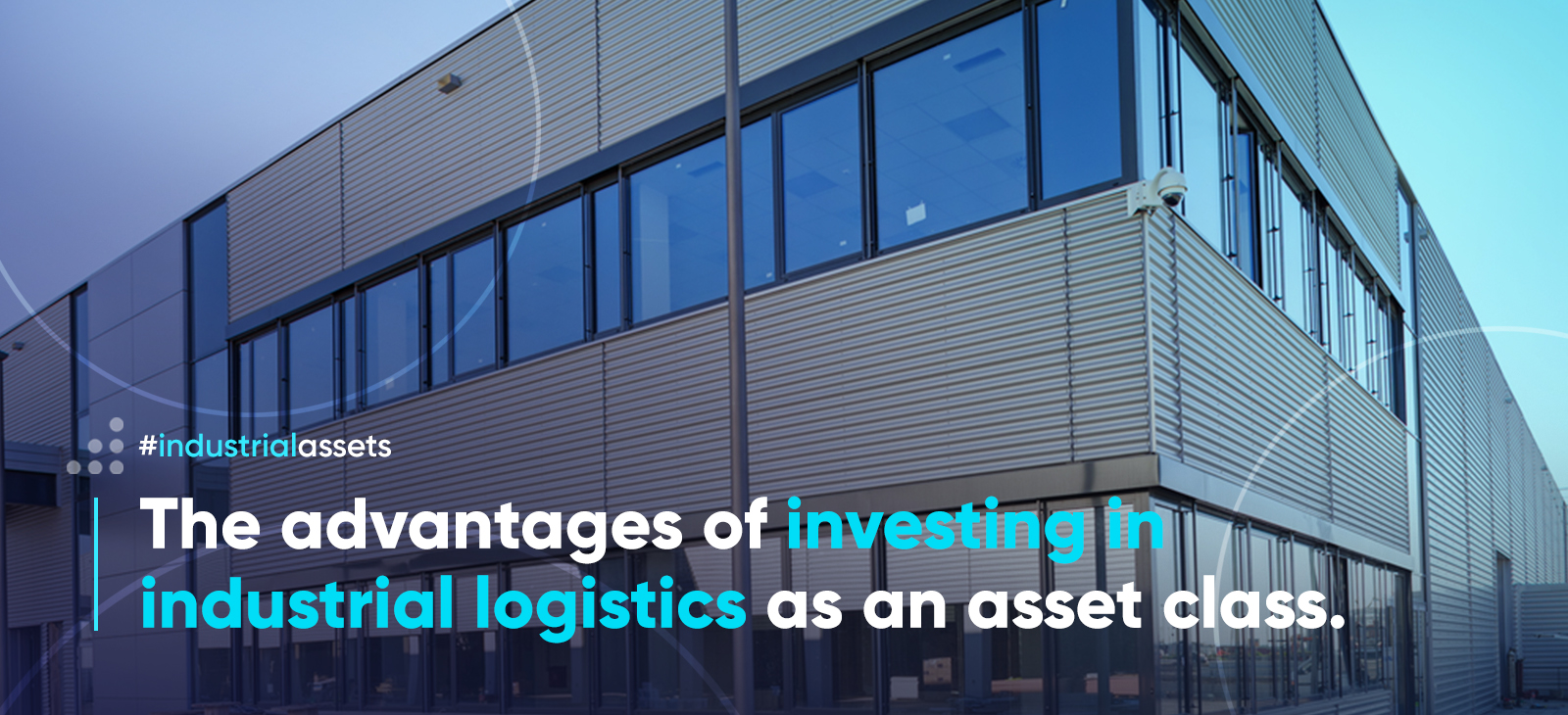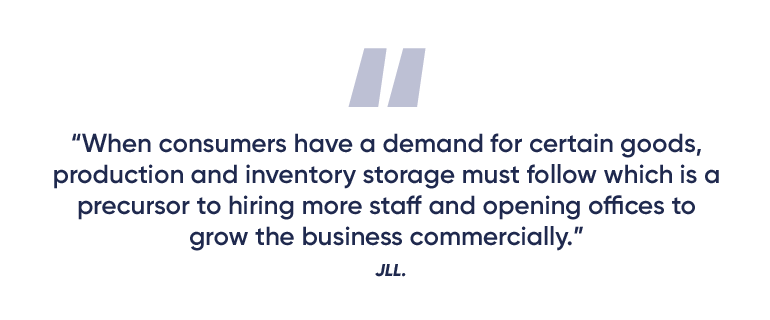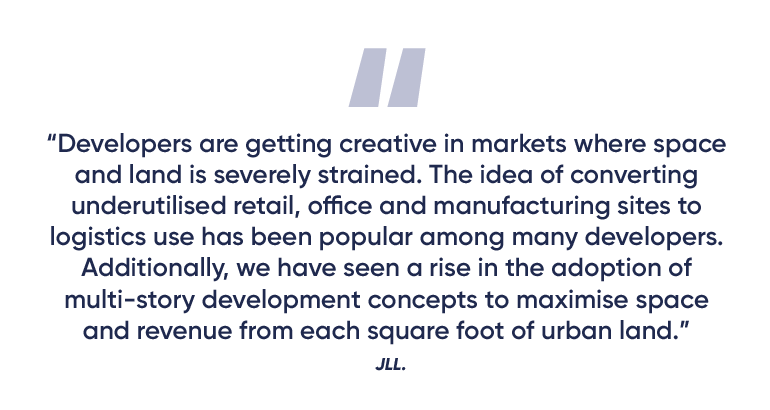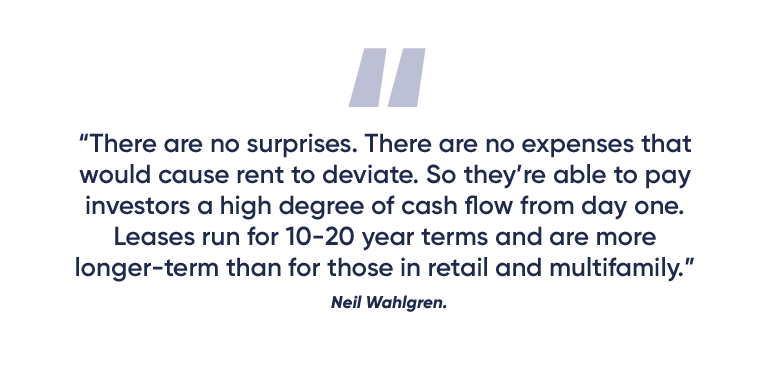
Understand the different types of industrial assets
The advantages of investing in industrial logistics as an asset class
Commercial real estate is a type of real estate that includes everything from office buildings to self-storage, warehousing for stock, and even businesses such as dry cleaners. Most businesses need physical space to run daily operations and that means investors have a large variety of investment opportunities when looking to include real estate in their portfolios.
This year commercial real estate reached a new record of $292 billion (USD), the highest first-quarter level in the first three months of 2022, according to JLL.1 The previous record was before COVID-19 for the first quarter of 2018, reaching a target of $225 billion (USD).2 Wealth Migrate believes in the strength of real estate as people need various properties to live in and work in, and for diversification, it’s also a bonus to have different classes of real estate assets to boost an investment portfolio’s growth potential.
Once an investor has a broader understanding of each investment’s asset class, this can help an investor unlock the economic potential of investing in specific types of property. In terms of diversification, Wealth Migrate also offers further insight into its deals to assist investors with evaluating if the deal is the correct fit for their investment portfolios.
Commercial real estate is split into four main areas: office, industrial, retail, and multi-family.3 Even with this distinction each asset class is further separated into sub-categories. There are also more niche asset classes that aren’t typically included within these sub-categories such as hotels, self-storage, medical offices, senior housing, student housing, and land. 4
In commercial real estate, industrial buildings are used for heavy industry – production and manufacturing, which requires heavy equipment or machinery, or accommodates complex production processes (such as pharmaceutical production).5 Examples include factories, manufacturing plants, and production plants.

Understanding the different types of industrial property
Businesses need industrial properties in order to run and operate, and these properties often must meet specific business needs in terms of machinery or land requirements, making it difficult to replace in terms of time and costs. Businesses make a big investment for the intended purpose of these buildings regarding the equipment for facilities and construction on the land. Industrial buildings are complex with multiple facilities needed to house different elements of production processes and tend to be built over a long time, maybe even years, as the business develops and grows.
Industrial real estate is very rarely a glamorous sector, the design is fit for function and to suit practicality and efficiency. There are a variety of uses that these types of buildings need to cover ranging from manufacturing to research and development, and the storage and distribution of goods. As the economy grows and demand increases for shopping, shipping, and storing; industrial space becomes more of a priority.6 Warehouse space is also affected by export and import activity.
What is industrial real estate: four types of properties
As industrial real estate supports commerce, four main categories have emerged:

- Manufacturing7
These cover factories with the assembly and production of goods and are the most common industrial building type. These properties tend to have less than 20% office space and can be further classified for heavy or light industrial use. These facilities can differ in size where a larger space may be used for heavy production needs or a smaller space for assembly. The types of labour needed also dictate space requirements, where humans are needed to personally be involved in product and manufacturing or robots in automated processes. There tends to be a blend of both in modern factories.
Even within factories, there are two main categories: ready-built factories and built-to-suit factories. Ready-built factories offer investment flexibility with financing and cater to the growth and development of a business over time. This is more suitable for companies that may not have enough money to finance the factory requirements all at once, such as start-up companies or smaller businesses.
Built-to-suit factories are large buildings that have been specifically designed to meet business needs. This is a costlier and lengthier commitment in terms of capital and effort, as these tend to run over 10-15 years for leases in order to ensure the landlord recoups their investment in this class of real estate.

- Warehousing8
This building suits commerce and ranges in use from the storage and distribution of raw materials and/or manufactured merchandise. These buildings have less than 15% office space, and modern facilities have high, clear ceiling heights. This is a necessity in order to cover load capacities and storage needs, and a warehouse may also include specialty facilities, such as cold or freezer storage for food.
Distribution and private are two different examples of warehouses. Distribution warehouses serve as storage for items, this can be raw materials or manufactured goods. This facility is a storage hub for the manufacturer and distributor, where items are shipped from this location, and it needs to be close to transport services and networks.
Private warehouses are used more for storage purposes than distribution such as cold storage for perishable items. Manufacturers prefer these smaller buildings and build these facilities close to production units. Due to the fixed size and cost of these buildings manufacturers tend to keep these buildings smaller for operations.

- Flex spaces9
The function of these spaces is to offer the most flexibility to the occupants. This can be known as tech or flex space (often used for research and development) as these are a mix of office buildings and warehousing. Considered to be an office-industrial hybrid, these spaces have 30% to even 100% office finish, data centres are also included in this category by real estate professionals.

- Data centres10
A data center is an industrial-scale facility that acts as the central point for a business’s IT operations and equipment. As data centres house the business’s crucial and proprietary assets these are a necessity. Due to the hi-tech requirements these facilities often house electrical switching, uninterruptable power supplies, backup generators, ventilation, and cooling systems. Similar to storage facilities, a high ceiling height is needed to support this equipment and cool the processing machinery. Data centres, therefore, need to be near a major power supply and communication lines to support extensive servers. There is also a high focus on physical and digital security to protect unauthorised access to the business and its information.

A competitive leasing environment is accelerating rent growth
The underlying value of industrial properties is aligned somewhat less to an economic cycle, but more to the business cycle of the products the facility produces – either to the products themselves or to the company producing them. As mentioned earlier, this asset class has its roots in production and has evolved enormously over the last few decades. Today, there are a variety of well-established property types within the Industrial asset class.
Neil Wahlgren, an established industrial real estate investor and sponsor, states that the advantages of investing in industrial real estate are that there is a certainty in the business.11 Investors know what returns they are receiving, and the leases tend to be more long-term and cater for rental increases.

The metrics that matter to industrial real estate cover the usage of physical space, time, and costs (capital planning and cost savings). As the imbalance of supply and demand for industrial real estate is expected to continue through 2023, these further compound the vital need for physical space that businesses need to operate. This influx means that industrial real estate is set to expand even further as demand remains high.
As part of an ongoing educational series, our next article will explore the rise of E-commerce, and the reasons for the boom in global logistics centres as real estate assets.
Find more Wealth Migrate content here:
We cover the topics of diversification, structured notes, purpose-built-co-living, and industrial real estate. Read below for the full list of Wealth Migrate content.
1 JLL. (May 2022). ‘Real estate investment hits record as headwinds emerge’. Retrieved from JLL.
2 JLL. (May 2022). ‘Real estate investment hits record as headwinds emerge’. Retrieved from JLL.
3 Crowdstreet. (June 2021). ‘Breaking down the nuances of each asset class’. Retrieved from Crowdstreet.
4 Crowdstreet. (June 2021). ‘Breaking down the nuances of each asset class’. Retrieved from Crowdstreet.
5 Crowdstreet. (June 2021). ‘Breaking down the nuances of each asset class’. Retrieved from Crowdstreet.
6 Guest writer. (January 2018). ‘Understanding the different types of industrial property’. Retrieved from Savills.
7 Guest writer. (January 2018). ‘Understanding the different types of industrial property’. Retrieved from Savills.
8 Crowdstreet. (June 2021). ‘Breaking down the nuances of each asset class’. Retrieved from Crowdstreet.
9 Guest writer. (January 2018). ‘Understanding the different types of industrial property’. Retrieved from Savills.
10 Guest writer. (January 2018). ‘Understanding the different types of industrial property’. Retrieved from Savills.
11 Wahgren, N., and Pan, S. (2022). ’How to invest in industrial real estate’. Retrieved from EverythingREI.